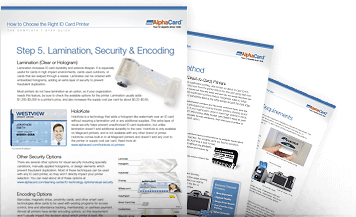Try ID Software for Free
Get 6-week Trial of AlphaCard ID Software
GO TO FREE TRIAL * No credit card neededBarcodes are the most common type of encoding, a feature available in almost all ID card software. They are quick and affordable to print because they do not require special ribbons, cards, encoding modules, or advanced software.
Barcodes work by creating a pattern of black and white areas (the lines, and the spaces between them), which can be scanned and read to decode the data. Unlike magnetic stripe encoding or smart code encoding, the data stored in barcodes is static and can’t be re-written.
Types of Barcodes

When adding barcodes to your cards, there are two general types you can choose from:
- 1D barcodes (one dimensional) are a series of vertical lines and spaces
- 2D barcodes (2 dimensional) are more complex and can store more information
1D barcodes can only be read in one direction, giving them limited space to store information. While there are many types of 1D barcodes, with varying limits on character length, 1D barcodes in general can only store small amounts of data like a member ID number or product number.
2D barcodes were created to hold more data, because their complex shapes are larger and can store information both vertically and horizontally. The most common type of 2D barcodes is a QR code, but there are several different types. These codes can hold 10 to 100 times more data than a 1D barcode, making them useful for storing more complex information such as a website page URL.
1D barcode encoding is found in almost all ID card software, including the most basic versions. 2D barcodes are sometimes included in more advanced versions, so check the software features before purchase if this is a feature you need.
Barcodes Are Best For
- Membership & Rewards Cards
- Time & Attendance Programs
- Library Cards

Using Barcodes
Barcodes were initially created to speed up the retail checkout process and make it easier to track inventory, but now they are used in almost every industry.
To use a barcode on an ID card, you first scan the barcode with a barcode reader. The reader feeds the data into a computer system, which pulls up the information associated with that code. The barcode itself does not store very much information, but simple points to the information stored in the database software.
For example, you probably have a rewards or membership card with your local grocery store. The barcode on your rewards card is scanned every time you make a purchase, giving you access to special members-only perks or sales.
But the barcode does not actually store all your membership information; it just contains your member ID number because there isn’t enough space to store all the data. When the barcode is scanned, however, the software will pull up your account because it is tied to your member number.




